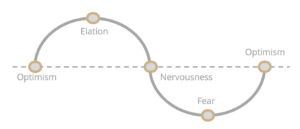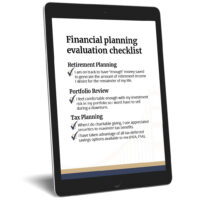
Why investment process quality is key to investing success + our 5 step approach
It’s natural to feel anxious about investing. Investors all want to make the best decisions when it comes to their money and wealth management—decisions that will help your portfolio grow bigger without excessive risk. However, the investment decision process can be overwhelming, given the many available options and pitfalls. And when you’re entrusting the planning and management of your financial future to a professional, you’re likely to have questions.
Investing is a key piece of a comprehensive personal wealth management, company-sponsored retirement plans, and endowment management. We believe that a well-built investment process can lead to better outcomes and more stable returns in the long run. We’ll help you by outlining our process, step by step.
An investment process is essential for long-term portfolio growth
While the prevailing advice to “stay the course” and “stick to the plan” is generally sound during volatile markets, primarily if your “course” and plan are properly defined, it’s easier said than done. From so-called experts who claim to predict market moves, to headlines and current events, investors often find themselves anxious and pulled in many directions when it comes to investing.
If you’re like most people, you may struggle to separate emotions from your investment decisions. You might swing from optimism and excitement to nervousness and fear, and then back again.

Many investors struggle to separate emotions from investment decisions.
This ongoing, reactive cycle is nerve-racking—and it can lead to poor financial decisions.
The physiological tendency of the electrical activity in the brain is to shift during periods of concern from the large part of the brain responsible for thoughtful decisions, to the tiny part of the brain responsible for the fight, fight or freeze responses. In the absence of a process connected to a long-term plan, process and financial behavior coaching, the tendency to shift to emotional investing is much greater.
Having a prudent investment process in place before emotions run high is key. As financial advisors, having a process allows us to guide you and make rational decisions based on facts, research, historical evidence, a set of decision criteria and decades of experience, rather than short-term thinking and fear. For investors, having a vetted process helps deter emotional decisions which often times don’t produce the best results.
“Planning, patience, consistency, research, diversification, low costs, and clear goals – these are the most important factors in long-term investing success.” -Greg Patterson, MBA, CEO of The Advisory Group, LLC.
Whether your aim is to reduce taxes, put the kids through college, or make work optional and secure your own retirement, a proper investment process is a critical element of an effective strategy to achieve short and long-term financial goals.
Building the foundation: Our investment philosophy
A sound investment process starts with a set of guiding principles, which we refer to as the “investment philosophy”. These principles serve as a framework for making choices when it comes to your investment strategy. At The Advisory Group of San Francisco, LLC, the philosophy that guides our process is based on decades of experience, respected research, and industry best practices.
With this philosophy as a roadmap, there’s always a clear path to follow—regardless of what the markets are doing, what the pundits are saying, or what your emotions are telling you. In other words, an investment philosophy cuts through the noise and provides a strong foundation for a disciplined, institutional-quality investment process.
The key drivers of our investment philosophy are:
Client-centric approach
The entire investment process starts with you. Through discovery and goal-setting sessions, we learn what’s important to you—where you stand, what you want to accomplish, by when, and how much risk you’re willing to take. In the case of an individual or family, financial planning is a key backdrop for appropriate investment decisions. For endowments, an appropriate spending policy is often a key driver. For retirement plans, employee demographics and fiduciary philosophy are central to designing and implementing an investment menu.
From there, we help clients develop their top-level investment policy decision, the stock/bond mix(es), and tailor investment strategies to align with your individual situation, goals and comfort level. We educate you on the investment process, making sure you understand each step, as well as any associated risks.
Structured decision-making
Building your investment portfolio should never be a guessing game. Studies indicate that investors should prioritize decisions based on their impact on results. The questions which guide our investment policy guidance and decision-making (in order of importance) are:
- What is the time horizon of the investment strategy? – How long until retirement or until spending begins?
- What is the distribution need from the portfolio? – How much will you need to withdraw and when? This also relates to time horizon(s).
- What asset classes should be considered? – What proportion will be in the portfolio: stocks, bonds, or cash equivalents?
- What will be the mix between asset classes? – What is the ratio of stocks to bonds and other asset types?
- What sub-asset classes will be considered? — Which types of bonds, foreign vs domestic stocks, alternative investments (if any) and other sub-asset classes will improve the risk/reward profile?
- Which investment managers will be selected? -What are their long-term capabilities, based on their people, process and performance?
“When it comes to choosing asset classes for the portfolio, we look at a broad array of domestic and foreign equities (stocks) and fixed income (bonds),” Senior Advisor Tanya Rapacz, CFP® explains, “After determining the investment policy target percentage, we then diversify further into an array of sub-asset classes. This may include, for example, mid and small cap U.S. equities, emerging markets securities, high-yield bonds, and real estate investment trusts. Often, there are a total of about 20 different sub-asset classes, and the way portfolios are structured also depends on whether a portfolio is taxable or tax-deferred.”
When we invest for our clients at The Advisory Group, we avoid overly concentrated positions in a single security. Our portfolios tend to be highly diversified—across sectors, market capitalizations, geography, and investment styles.
“We do not make short-term tactical decisions regarding sub-asset classes or investment managers (e.g. mutual funds), however, we do periodically make medium-term strategic adjustments. For example, given that extended periods of low interest rates are almost always followed by higher rates, we increased our allocation to short-term bonds for a period of time. This reduced portfolio volatility when rates eventually rose. Also, when rates are low for an extended period of time due to government economic stimulus efforts, higher inflation is typically eventually a result. We added an allocation to ‘Real Assets’ strategies before inflation rose, as a hedge against inflation,” says CEO Greg Patterson. Once inflation and rates mostly normalized, we removed Real Assets from client portfolios, and returning our short-term or “defensive” bond position to our more typical allocations.”
Committee oversight
The role of the Investment Committee is to build long-term, tax-efficient (where applicable) portfolios through 5 key actions:
- Asset Allocation: After guiding you to an appropriate stock/bond mix policy, we determine an optimized mix of investments for you within the stock and bond categories.
- Investment Selection: We choose high-quality, experienced, specialist, disciplined investment managers to manage each asset class within portfolios.
- Rebalancing: We carefully monitor and adjust your portfolio’s target allocation to prevent market movements from causing your portfolio to stray too far from your policy stock/bond mix, i.e. your appropriate risk profile.
- Tax Efficiency: For taxable portfolios, we minimize your tax burden within legal guidelines, with tax-efficient investment vehicles, tax loss harvesting and “asset location,” along with other strategies.
- Ongoing Monitoring: We continuously evaluate the risk profile and underlying investment managers within the portfolios using an institutional-quality due diligence process, and continue to refine and improve our processes.
“Our Investment Committee conducts investment manager searches, as necessary, and performs regular portfolio design reviews and investment manager due diligence. We analyze investment managers within the portfolio using a quantitative and qualitative process involving both art and science. Asset allocation study updates are conducted yearly,” notes Senior Advisor Lisette Smith, CFP®, CDFA®, MBA.
The primary reasons we replace investment managers within a portfolio are:
- Manager changes: Key personnel departures, especially “star” managers, whose talent the investment decisions relied heavily upon.
- Process issues: Problematic shifts in investment process or style, which may increase risk or reduce overall client diversification.
- Organizational changes: Structural changes that restrict research resources or modify the original strategy for reasons other than benefitting the end-investor.
- Strategic shifts: Removal of an asset class that has a reduced expected diversification benefit, or a temporary asset class used towards long-term goals.
Risk and return measures
Managing risk according to each client’s strategic plan is crucial, rather than chasing fads or investments with recent strong returns. This ensures that your investments align with your goals and risk tolerance, and focuses on investing through multiple complete market cycles, rather than just focusing on short-term patterns that tend not to last.
We address different types of risks, including investment risk, the impact of volatility relative to the timing of spending needs, behavioral risks, and more, to create a well-designed portfolio suited to your needs. We also measure, monitor and manage risk as part of our portfolio evaluation, rebalancing and investment manager due diligence processes.
Tax efficiency
For taxable portfolios, we use tax-loss harvesting to offset gains and reduce your tax burden, and other tax-efficiency strategies to further enhancing your overall returns. For taxable investors, it is the after-tax return, or personal balance sheet that is most important, rather than focusing entirely on high-return seeking investments that may have significant tax costs that can materially offset the published pre-tax returns.
Investment theories and practices
Modern Portfolio Theory (MPT) and Efficient Market Hypothesis (EMH) are two fundamental concepts in investment finance, that The Advisory Group’s Investment Committee incorporates into our process. MPT helps create diversified portfolios that maximize returns for a given level of risk, while EMH suggests that markets reflect all available information, making it hard to consistently beat the market. Together, these theories form the basis for many investment strategies focused on strategic asset allocation and risk management. They emphasize diversification and acknowledge the difficulty of consistently outperforming the market.
Asset optimization and diversification
Asset optimization focuses on arranging your investments in a way that aims to get the best possible returns for a given level of risk. It involves strategic (not tactical) selection of assets to fit your financial goals and risk tolerance, rather than attempting to time the market. Timing the market requires two perfect decisions: When to get out, and when to get back in. Studies show that disciplined investing more often leads to better results in the long-run, vs. attempting to guess the market’s movements.
“Timing the market is risky because it’s hard to predict when prices will rise or fall. A steady investment strategy is more likely to yield positive long-term results.” ~ Senior Advisor Lisette Smith, CFP®, CDFA®.
Asset optimization goes hand-in-hand with diversification to reduce risks, manage volatility, and enhance returns. Spreading your investments across different types of assets with different return patters or “correlations” —like stocks, bonds, real estate and many other sub-asset classes—reduces risk and tends to increase the stability of returns. This way, if one investment performs poorly, others may perform better, reducing fluctuations and balancing the overall outcome.
Rebalancing
Over time, asset allocations drift from their target percentages due to market movements, which alters the risk/return profile of a portfolio. Rebalancing restores the original asset allocation and “resets” risk to the intended target level—a key risk control that can also boost returns.
Rebalancing involves regularly reviewing your portfolio at the stock/bond mix level, as well as the sub-asset class level. We set different rebalancing parameters for each sub-asset class based on their projected volatility. This could mean trimming overgrown, higher-risk assets and reinvesting in undervalued sub-asset classes that may be poised for higher returns. This also means optimizing for after-tax returns, and using tax-loss harvesting to offset investment gains (so you pay less in taxes overall).
Mix of active and passive
Simply put, active management aims to outperform the market, while passive management seeks to match it. While some advisory firms feel strongly about only using one or the other, we use a mix of active and passive investment strategies to give you the best of both worlds.
For taxable assets, passive investing works to minimize taxes through lower security turnover and reduce capital gains distributions. For non-taxable assets, a combination of core passive investments and some active strategies are often appropriate.
Putting it all together: Our investment management process
It’s our experience that well-designed and prudent processes increase the likelihood of success over time. Based on this knowledge, the foundations of our investment philosophy, and your goals, we make investment decisions within the investment policy parameters jointly established with you, following our 5-step investment process:
1. Analyze your current situation
The first step is to assess your financial status, including income, expenses, assets, liabilities, and existing investments and the timing and level of future spending goals. Understanding your goals and planning as starting point provides a clear picture of your financial health and identifies areas for improvement, which is essential for creating a realistic and effective investment strategy.
2. Design the optimal portfolio
Next, we help you determine the stock/bond policy mix that fits your financial goals and plan, and develop a diversified portfolio tailored to those financial goals, as well as your risk tolerance, and investment time horizon. This involves selecting a mix of sub-asset classes that balance potential returns with acceptable levels of risk, aiming to maximize long-term growth while managing volatility.
3. Formalize investment policy
A written Investment Policy Statement (IPS) outlines your investment objectives, risk tolerance, asset allocation strategy, and guidelines for managing the portfolio. This document serves as a roadmap, ensuring consistency and discipline in investment decisions, and providing a framework for evaluating performance. A well written IPS also ensures that we, as the advisory firm, cannot change the risk parameters of your portfolio without your approval. The risk profile may change over time as your needs and goals evolve, but that is your decision, with our guidance, that is driven by the planning process.
4. Implement policy
Next, we execute the investment strategy by purchasing the chosen assets according to the parameters established in the IPS. This step reflects the culmination of our Investment Committee’s research process and careful selection to ensure that investments are made in line with the strategy, aiming to minimize costs and maximize efficiency.
5. Monitor and supervise
We conduct ongoing reviews of the portfolio’s performance and compare it against the IPS, and conduct rebalancing adjustments as necessary to respond to changes in market conditions, to keep the portfolio aligned with the long-term objectives. We work with you to adjust the investment policy over time as personal circumstances or investment goals evolve.
Don’t navigate the investment journey alone
Building and maintaining wealth is complex. A structured process helps form the foundation for long-term investment success. Having an expert team can make all the difference, whereas going it alone can be risky—not to mention time-consuming.
Our team of experienced fiduciary advisors offers:
- Personalized investment plans tailored to your goals and risk tolerance.
- Behavioral finance coaching to help you stay focused and avoid impulsive decisions. even at the worst moments.
- Expertise to help you navigate market changes and identify opportunities, as your circumstances evolve.
- Peace of mind that your best interests always come first.
Have one of our professionals guide you through the investment maze, so you navigate your financial future with confidence. Contact us for a free consultation.
The information provided herein is for informative and educational purposes only. The use of hyperlinks to third party websites is not an endorsement of the third party. Third party content has not been independently verified. To understand how this content may apply to you, please contact a financial advisor.





